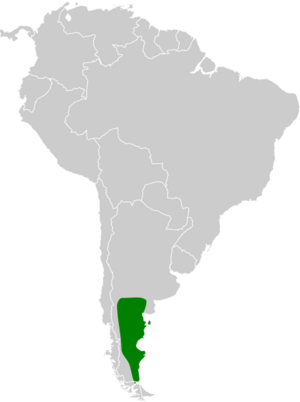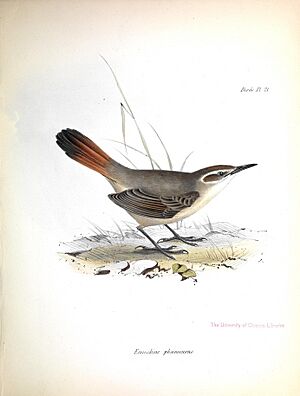Band-tailed earthcreeper facts for kids
Quick facts for kids Band-tailed earthcreeper |
|
|---|---|
 |
|
| Conservation status | |
| Scientific classification | |
| Genus: |
Ochetorhynchus
|
| Species: |
phoenicurus
|
 |
|
| Synonyms | |
|
Eremobius phoenicurus (Gould, 1839) |
|
The band-tailed earthcreeper (Ochetorhynchus phoenicurus) is a cool bird that belongs to the ovenbird family. You can find these birds living in parts of Argentina and Chile. They are known for their unique tail feathers and how they search for food on the ground.
Contents
About the Band-tailed Earthcreeper
What's in a Name?
Scientists give every living thing a special name. The band-tailed earthcreeper's scientific name is Ochetorhynchus phoenicurus. This bird is the only one of its kind in its group, which means it is called "monotypic."
How to Spot One
The band-tailed earthcreeper is a small bird. It is about 16 to 17 centimeters (6 to 7 inches) long. It weighs around 28 to 34 grams (1 to 1.2 ounces), which is about the weight of a few AA batteries.
Both male and female birds look alike. They have a white stripe above their eye, like an eyebrow. There's also a dark stripe behind their eye. Their cheeks are a reddish-brown color. The top of their head and back are a plain dull gray-brown.
Their tail feathers are special! The two middle feathers are dark blackish. The other tail feathers have a clear line between reddish-brown bases and black ends. Their wings are dull gray-brown.
The bird's throat is whitish, and its chest and belly are a pale dull gray-brown. You might see lighter streaks on its chest. Their eyes are dark brown. Their bill (beak) is black or dark brown, with a lighter gray or horn color at the bottom part. Their legs and feet are dark brown or black. Young birds have lighter edges on their forehead feathers and fainter streaks on their undersides.
Where Do They Live?
Home Sweet Home
The band-tailed earthcreeper lives in southwestern Argentina. This area is between the Neuquén and Santa Cruz provinces. You can also find them in the northeastern part of southern Chile's Magallanes Region.
Their Favorite Places
These birds love dry areas like scrublands and temperate grasslands. They prefer open plains, plateaus, and slopes that don't have too much thick plant growth. You can find them from near sea level up to about 1,200 meters (3,900 feet) high.
How They Live Their Lives
Staying Put
The band-tailed earthcreeper is a "resident" bird. This means it stays in the same area all year long and does not migrate.
What's for Dinner?
These birds are ground feeders. They usually search for food by themselves. Their diet mainly consists of arthropods, which are creatures like insects and spiders. They use their thin, straight bills to probe into bare ground, rock cracks, and grass clumps. They also look for food in cushion plants.
Building a Family
Band-tailed earthcreepers are thought to have one partner for life. They breed during the austral summer, which is from September to January in the Southern Hemisphere.
They build a ball-shaped nest using thorny twigs. The nest has a side entrance that leads to a tunnel. This tunnel then opens into the nest chamber. They usually place their nests about 1 to 2 meters (3 to 7 feet) off the ground in a low bush or a cactus. They line the inside of the nest chamber with soft materials like hair, flowers, and feathers. A female bird usually lays two to four eggs. Scientists are still learning about how long the eggs take to hatch and when the young birds leave the nest.
What Do They Sound Like?
The band-tailed earthcreeper's song is a "fast dry trill." Sometimes, it ends with separate, sharp "ti" notes. When they are alarmed, their call is a repeated, husky "suwee" or "wheet."
Their Status in the Wild
The IUCN (International Union for Conservation of Nature) has looked at the band-tailed earthcreeper. They have assessed it as a species of "Least Concern." This means it is not currently in danger of disappearing.
However, its range is somewhat limited. The total number of these birds is not known, and it is believed to be decreasing. Luckily, no immediate big threats have been found. The bird is considered uncommon to fairly common. Its habitat seems pretty safe, with too much grazing by animals being the main human-caused problem.



